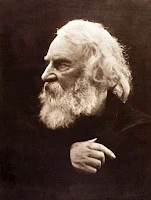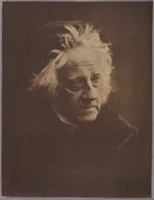Happy U.S. publication day and review of Julia Margaret Cameron By Herself, Virginia Woolf And Roger Fry
This book reprints Virginia Woolf's witty and moving biographical essay of her great-aunt, and Roger Fry's pioneering study of the photographs published together in 1926 under the title Victorian Photographs of Famous Men and Fair Women. To these are added Julia Margaret Cameron's own auto-biographical fragment, Annals of the Glass House, and her only surviving poem, On a Portrait. They are introduced by Tristram Powell. Tristram Powell is a film-maker and historian of photography.
Virginia Woolf (1882-1941), a central figure of the Bloomsbury Group, is best known for the nonlinear narrative of her novels, and for her feminism.
Roger Fry (1866-1934), painter and critic, was another member of the Bloomsbury Group. He was a leading champion of Post-Impressionism.
Daguerreotype portrait of Julia Margaret Cameron and her daughter, Julia Hay Cameron by Unknown, 1845, National Media Museum
The photographer is unknown but it is possible that the image was made
in Calcutta as both mother and daughter were there until January 1845,
after which 'Little Julia' returned to England for three years. The case
is inscribed by the daughter 'Feb 10th 1845. This for me to keep', and
probably at a later date by her mother 'Given to my Julia by her request
- her own choice.' Julia Hay Cameron died in childbirth in her early
30s, at which point the portrait appears to have been returned to her
mother. (This portrait is now housed at Dimbola Lodge, Freshwater Bay, Isle of Wight, home of Julia Margaret Cameron. This image is not included in the book. I added it because its beautiful)
At the age of forty-eight, Julia Margaret Cameron (1815-1879) was given a camera by her daughter when she moved to the Isle of Wight: 'It might amuse you, Mother, to try to photograph during your solitude at Freshwater.' The gift was to begin Mrs.Cameron's short but prolific career as one of photography's first great artists.
Cameron's long exposures and softfocus portraits were criticised by photographers of the time as lacking skill, but these evocative manipulations were in fact early realisations of photography's true poetic potential. Such expressiveness was something more readily understood by the Pre-Raphaelite painters with whom Cameron became associated, and who gave her encouragement.
Her portraits capture some of the most famous intellectuals and artists of the Victorian era, all made to follow Mrs. Cameron's famously exacting direction.
PRODUCT DETAILS
Julia Margaret Cameron By Herself,Virginia Woolf, Roger Fry
BIOGRAPHY & AUTOBIOGRAPHY
128 Pages, 4.5 x 5.75
Formats: Trade Paper
Trade Paper, $16.95 (US $16.95) (CA $22.95)
Publication Date: October 2016
ISBN 9781843681212
Rights: US & CA
128 Pages, 4.5 x 5.75
Formats: Trade Paper
Trade Paper, $16.95 (US $16.95) (CA $22.95)
Publication Date: October 2016
ISBN 9781843681212
Rights: US & CA
Pallas Athene (Oct 2016)
In a letter to Sir Edward Ryan she says, 'Lastly as to spots, they must, I think remain. I could have them touched out, but I am the only photographer who always issues untouched photographs and artists for this reason, amongst others, value my photographs. So Mr. Watts and Mr. Rossetti and Mr. du Maurier write me above all others'. (Julia Margaret Cameron's letter, pg. 18).
Dear Reader, if you are in search of first-hand accounts from Mrs. Cameron herself, her family members, closest friends, scholars, and the like then look no further. For this small booklet is quite intimate and charming. There are myriads of biographies on photographer, Julia Margaret Cameron's life and work. However, I am so in love with this beautiful yet introspective look beyond the lens into Mrs. Cameron's world in Ceylon and Freshwater Bay, Isle of Wight.
It is as if her closest friends have gathered together all of Mrs. Cameron's surviving writings (Annals of the Glass House), excerpts from her letters to colleagues, family, and friends, as well as critiques of the day written by family members and scholars of photography and history. There is no better research than personal artifacts from the subject. Yes, we have her photographs but there was so much more to the woman behind the standing box camera lens.
Julia Margaret Cameron with sons Henry Herschel Hay and Charles Hay, 1857-8
by an unknown photographer, Harry Ransom Center
I was shocked when I read the story of Julia's father in his coffin returning home with his widow and young children (including a very young child named Julia Margaret) when his coffin exploded with him in it! Apparently, James Pattle was something of a liar and a scoundrel with a temper! There are several fascinating stories about young Julia Margaret Pattle's childhood and family; yes, she was born a Pattle before marrying Charles Hay Cameron later in life and having her family. So many wonderful mentions of Mr. Cameron, his viewpoint on living on their coffee plantation in Ceylon, his thoughts on his wife, Julia Margaret, their life together, etc. It is worth the money for learning about that rare aspect of her personal life alone!
If you want to learn more about the poets and scholars of Freshwater Bay on the magical Isle of Wight, all her friends are gathered within these pages. Focus is put on the famous laureate, Alfred, Lord Tennyson but deeper exploration into Julia Margaret's earlier friendship with great men such as poet and essayist, Sir Henry Taylor and astronomer, chemist, polymath Sir John Herschel just to name a few! Wonderful descriptive stories of dinners and parties at her sister Sarah Prinsep's Little Holland House. I could have stayed there forever.
There are fifty of Julia Margaret Cameron's photographs numbered and labeled as plates. Next to each photograph is a story and anecdote of that particular friend and sitter. However, some wonderful stories of the famous visitors who met Mrs. Cameron and didn't exactly like or get on with her! Very funny tidbits indeed.
One of my favorite quotes from the book is one I often remember and know to be true even to this day. I should know because I am blessed to have visited Freshwater Bay, Isle of Wight and most of my very dear 'friends' remain there...
Everybody is either a genius, or a poet, or a painter or peculiar in some way.
Is there nobody commonplace?
I am forever grateful to Trafalgar Square Publishing, Independent Publishers Group as well as Pallas Athene for mailing me a beautiful hardcover edition of, Julia Margaret Cameron By Herself, Virginia Woolf and Roger Fry for review. I will cherish it always.
Now published in the United States and available for purchase, Amazon US
Already published in the United Kingdom and available for purchase, Amazon UK









Comments
Yet most of the art history students in the USA with whom I have discussed Roger Fry.. don't seem to know his legacy. I hope "Julia Margaret Cameron By Herself, Virginia Woolf and Roger Fry" encourages American undergrads to consider the huges pre-WW1 changes that Fry was so involved in.
Is there nobody commonplace?
I just love this quote.
Thank you for sharing Kimberly.